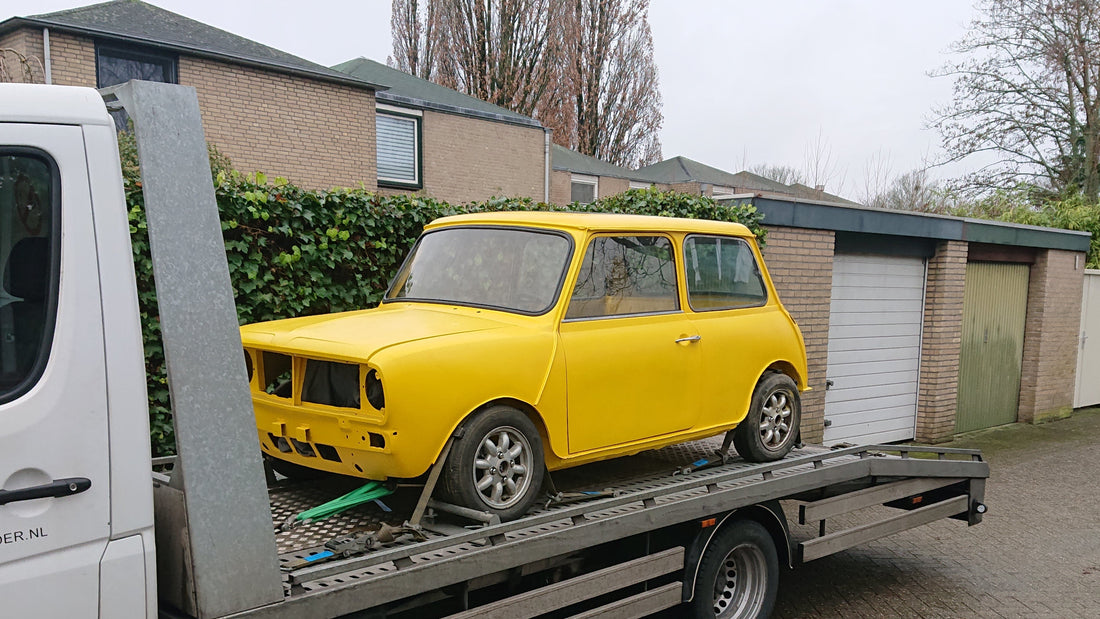
Classic Mini Clubman conversion from petrol to electric
Share
I have been working on restoring an old Mini Clubman from 1973 for a while, which I once bought during my studies in automotive engineering. Over the years - yes, I have been working on it for a while - there have been many different ideas.
After spending some years driving a Mini (Sprite, 1992), I ended up all the way in Friesland via Marktplaats for such a beautiful Innocenti dashboard, for in that other Mini. There was also this Mini Clubman there in not the best condition, but for a price that made me think: 'I can't leave it there for this!' So a week after I picked up the dashboard, I went back with a big bus and trailer to pick up the Clubman and a lot of extra parts. So two trips back and forth across the country in one week, but then the party could begin. We will take this Clubman apart, fix it up and put it back together as it should be.
At least, that were my thoughts then. Due to increased pressure in the last two years of my studies, the Clubman was almost completely dismantled for the remaining study period. Dismantling was done in no time, it didn't take two weeks... Later, after graduating, I picked up the job again. But after graduating, working life started and then the moment comes that you finally leave your parents' house. So first I left the house myself and came to do some odd jobs in the weekends. Then it was also time to move the Clubman itself, however, that was to a village or two further away. There I found a nice shed where I could do odd jobs. During this period, the wildest ideas came up, where I eventually planned the following major interventions: 1) the A-series block had to make way for a Honda D15Z8 (with eco vtec) and 2) the rickety, leaking sliding roof that was in it when I bought it, was replaced by a panoramic sliding roof from a new Mini Cooper (~2005).
Both jobs were quite intensive and required quite a bit of metalworking, but the sunroof was installed quite quickly. All in all, the roof of a new Mini doesn't fit that badly on an old one! The Honda block, however, was a bit more difficult. The complete modification of the subframe (in several iterations) caused quite a bit of frustration over time, but I eventually got that in too. But then... It's always a bit tricky to get the intake manifold of a Honda into a Mini without - either cutting into the bulkhead (no go for me) - or cutting through the intake manifold and welding it back together at a different angle. The latter was at most a last resort for me. Something better had to be found for this and I found it in the form of a 3D printer. This is where my passion for 3D printing was ignited.
With my brand new ownership of my own 3D printer, I started working with 3D CAD software to design my own intake manifold. Many evenings were spent behind the computer screen and after several iterations I had a suitable design that fit neatly in the engine compartment and could also be printed from the right material. It has now been a few years since the Clubman was painted. The total Honda conversion was still quite a job and I decided to investigate again how much effort (and especially money) it would take to make the Clubman electric. I had also looked into this when I had just started working after my studies. Due to sky-high costs I let that go at the time, it was certainly not an option at that time.
But, as I said, a few years have passed and last year I decided to take another look at how things are going in EV conversion land. My conclusion, time has not stood still there either. In the meantime, there are aftermarket controllers (in my case Resolve-EV) available that can control the entire drivetrain of a Nissan Leaf and Nissan Leaf parts have also become relatively affordable. So last April (2024) I made the decision to say goodbye to petrol in my car once and for all. Mind you, to say goodbye, because we are not there yet.
In itself, adapting (an original) Mini subframe for the Leaf was done relatively quickly and it all seems to fit quite well up front. The batteries, on the other hand, are a bit more of a challenge. After all, a Mini is not called a 'Mini' for nothing. After much trial and error, we arrived at: full engine stack in the engine compartment, a quarter of the batteries under the rear seat, a quarter of the batteries on the rear seat and the rest of the batteries in the trunk.
In this conversion, 3D modeling and printing also play an important role, but more about that later. For this total design and conversion process, there are still a number of things open, but for this blog post I will leave it at that. It is now a nice summary of how I got where I am now, so that I can take you further with me in the continuation of my EV conversion.
See you soon!